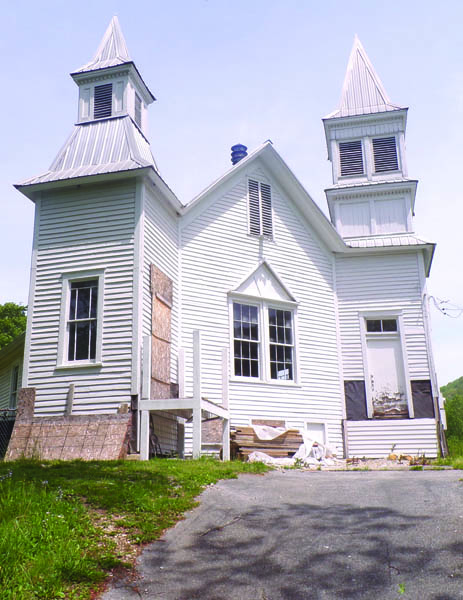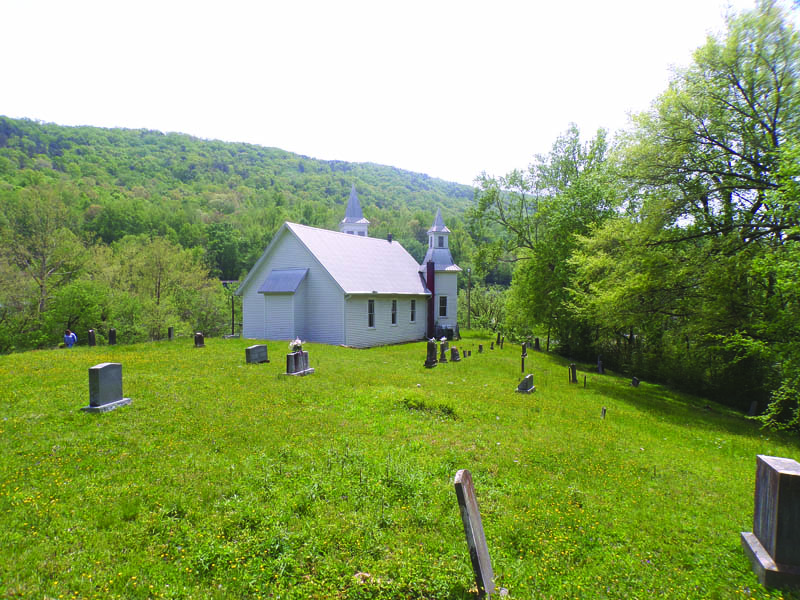The sentinel of a community
A white frame church with two steeples has stood sentinel for 136 years atop a hill in the center of Briceville.
It was built by Welsh miners in 1887 on land donated by the Coal Creek Mining and Manufacturing Company.
The building, which is the oldest church in Briceville, started out as Briceville Community Church and served Methodists, Baptists and Presbyterians. As other denominations built their own churches, it was taken over by the Methodist Church.
In 1930, the Holston Methodist Conference renamed it the Briceville Methodist Church.
The Rev. John Thomas, a large landowner in the valley, donated the land for the cemetery in back of the church. The oldest tombstone is that of John Irish who died on Jan 17, 1889. The cemetery was organized in 1908 as the Briceville Union Cemetery.
Over the years the church hosted revivals, weddings, funerals and Vacation Bible Schools as well as Sunday services in the center of the once thriving community of Briceville. At one time more than 1,500 men worked in a dozen mines in the area. In 1900 R.G. Dunn (the forerunner of Dunn & Bradstreet) listed 29 businesses in Briceville including four groceries, one drug store, one watch repair shop, seven general stores, and two confectionaries.
On the church grounds is a large stone block ladies used to get into and out of wagons and buggies. The building still has the original leaded glass windows and there is a bell in the larger of the two steeples.
In 1902 during the Coal Creek War in which miners fought with the Tennessee National Guard of over the use of convict labor in the mines, the church was used as a jail for captured miners.
The cemetery contains the remains of 22 of the 300 miners killed in the 1902 Fraterville Mine explosion and the 1911 Cross Mountain mine explosion. One of the last burials was in 2021.
One of the most memorable pastors was the Rev. John C. Cline who served the church from 1947 until 1965. He was there to serve the community as well as the church and always offered help in times of trouble no matter a person’s church affiliation. The Rev. Cline had a 1940 Ford truck he would use to go around the community and pick up children for vacation Bible school. He also used the truck to bring goats up the hill to keep the cemetery cleared.
The Briceville Volunteer Fire Department came into existence in 1974 and is located on land at the foot of the hill donated by the church.
The affiliation with the Methodist Church ended in June 1995. The church once again became Briceville Community Church and nondenominational services were held for several years until the last members of the congregation died.
The property changed hands several times after the last members of the congregation died. In 2008 the church was placed on the National Registry of Historic Places. In 2018 the property came into the hands of a committee of six people including Daphne Windham.
At the present time the church is not in use because the doors are boarded up.
Windham said that in the 1950s concrete steps were built leading up to both church doors. There was no flashing placed behind the steps and over the years collected moisture caused the woodwork beneath the doors to rot out. Other than that Windham says the building is structurally sound. With donations and volunteer labor Windham and her committee would like to restore the church and open it for funerals, weddings and other community activities. Anyone interested in donating to the restoration or contributing labor can call Windham at (865) 385-1705
Editor’s note: Much of the material in this article came from the book “The Sentinel - Keeping Watch Over Briceville” by Eugenia Robinson Ahrens.




